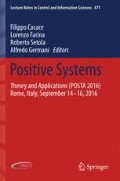Abstract
This chapter deals with the control of anesthesia taking into account the positivity together with the upper limitation constraints of the variables and the target interval tolerated for the depth of anesthesia during a surgery. Due to the presence of multiple time scale dynamics in the anesthesia model, the system is re-expressed through a singularly perturbed system allowing to decouple the fast dynamics from the slow ones. Differently from general approaches for singularly perturbed systems, the control objective is then to control and accelerate the fast subsystem without interest in modifying the slow dynamics. Thus, a structured state feedback control is proposed through quasi-LMI (linear matrix inequalities) conditions. The characterization of domains of stability and invariance for the system is provided. Associated convex optimization issues are then discussed. Finally, the theoretical conditions are evaluated on a simulated patient case.
Access this chapter
Tax calculation will be finalised at checkout
Purchases are for personal use only
Notes
- 1.
The time dependence is omitted for simplicity of the notation.
- 2.
References
Lemos, J.M., Caiado, D.V., Costa, B.A., Paz, L.A., Mendonca, T.F., Esteves, S., Seabra, M.: Robust control of maintenance-phase anesthesia. IEEE Control Syst. Mag. 34(6), 24–38 (2014)
Soltesz, K., Hahn, J.-O., Dumont, G.A., Ansernimo, J.M.: Individualized PID control of depth of anesthesia based on patient model identification during the induction phase of anesthesia. In: IEEE Conference on Decision and Control and European Control Conference (CDC-ECC) Orlando USA, pp. 855–860, December 2011
Haddad, W.M., Hayakawa, T., Bailey, J.: Adaptive control for non-negative and compartmental dynamical systems with application on general anesthesia. Int. J. Adapt. Control Signal Process. 17(3), 209–235 (2003)
Gentilini, A., Schaniel, C., Morari, M., Bieniok, C., Wymann, R., Schnider, T.: A new paradigm for the closed-loop intraoperative administration of analgesics in humans. IEEE Trans. Biomed. Eng. 49(4), 289–299 (2002)
Beck, C.L.: Modeling and control of pharmacodynamics. Eur. J. Control 24, 33–49 (2015)
Zhusubaliyev, Z.T., Medvedev, A., Silva, M.M.: Nonlinear dynamics in closed-loop anesthesia: pharmacokinetic/pharmacodynamic model under PID-feedback. In: American Control Conference, pp. 5496–5501, Portland, USA (2014)
Fiacchini, M., Queinnec, I., Tarbouriech, S., Mazerolles, M.: Invariant based control of induction and maintenance phases for anesthesia. In: 6th IFAC Conference on Foundations of Systems Biology in Engineering (FOSBE), MAgdeburg, Germany, October 2016
Kokotovic, P.V., Khalil, H.K., O’Reilly, J.: Singular Perturbation Methods in Control; Analysis and Design. Academic, New York (1986)
Garcia, G., Tarbouriech, S.: Control of singularly perturbed systems by bounded control. In: American Control Conference, Denver, USA, pp. 4482–4487 (2003)
Lizarraga, I., Tarbouriech, S., Garcia, G.: Control of singularly perturbed systems under actuator saturation. In: 16th World IFAC Congress, pp. 243–248, Prague, Czech Republic (2005)
Derendorf, H., Meibohm, B.: Modeling of pharmacokinetic/pharmacodynamic (pk/pd) relationships: concepts and perspectives. Pharm. Res. 16(2), 176–185 (1999)
Haddad, W.M., Chellaboina, V., Hui, Q.: Nonnegative and Compartmental Dynamical Systems. Princeton (2010)
Coppens, M.J., Eleveld, D.J., Proost, J.H., Marks, L.A., Van Bocxlaer, J.F., Vereecke, H., Absalom, A.R., Struys, M.M.: An evaluation of using population pharmacokinetic models to estimate pharmacodynamic parameters for propofol and bispectral index in children. Anesthesiology 115(1), 83–93 (2011)
Minto, C.F., Schneider, T.W., Shafer, S.L.: Pharmacokinetics and pharmacodynamics of remifentanil. Model application. Anesthesiology 86(1), 24–33 (1997)
Schnider, T.W., Minto, C.F., Gambus, P.L., Anderson, C., Goodale, D.B., Young, E.: The influence of method of administration and covariates on the pharmacokinetics of propofol in adult volunteers. J. Am. Soc. Anesthesiol. 88(5), 1170–1182 (1998)
Bailey, J.M., Haddad, W.M.: Drug dosing control in clinical pharmacology. IEEE Control Syst. Mag. 25(2), 35–51 (2005)
Berman, A., Neumann, M., Stern, R.J.: Nonnegative Matrices in Dynamic Systems. Wiley-Interscience, John Wiley and Sons, New York, USA (1989)
Tarbouriech, S., Garcia, G., Gomes da Silva Jr., J.M., Queinnec, I.: Stability and Stalization of Linear Systems with Saturating Actuators. Springer (2011)
Boyd, S., Ghaoui, L.E., Feron, E., Balakrishnan, V.: Linear Matrix Inequalities in System and Control Theory. Society for Industrial and Applied Mathematics, June (1997)
Zabi, S., Queinnec, I., Tarbouriech, S., Garcia, G., Mazerolles, M.: New approach for the control of anesthesia based on dynamics decoupling. In: 9th IFAC Symposium on Biological and Medical Systems (BMS 2015), Berlin, Germany (2015)
Author information
Authors and Affiliations
Corresponding author
Editor information
Editors and Affiliations
Rights and permissions
Copyright information
© 2017 Springer International Publishing AG
About this chapter
Cite this chapter
Tarbouriech, S., Queinnec, I., Garcia, G., Mazerolles, M. (2017). Control of Anesthesia Based on Singularly Perturbed Model. In: Cacace, F., Farina, L., Setola, R., Germani, A. (eds) Positive Systems . POSTA 2016. Lecture Notes in Control and Information Sciences, vol 471. Springer, Cham. https://doi.org/10.1007/978-3-319-54211-9_2
Download citation
DOI: https://doi.org/10.1007/978-3-319-54211-9_2
Published:
Publisher Name: Springer, Cham
Print ISBN: 978-3-319-54210-2
Online ISBN: 978-3-319-54211-9
eBook Packages: EngineeringEngineering (R0)

